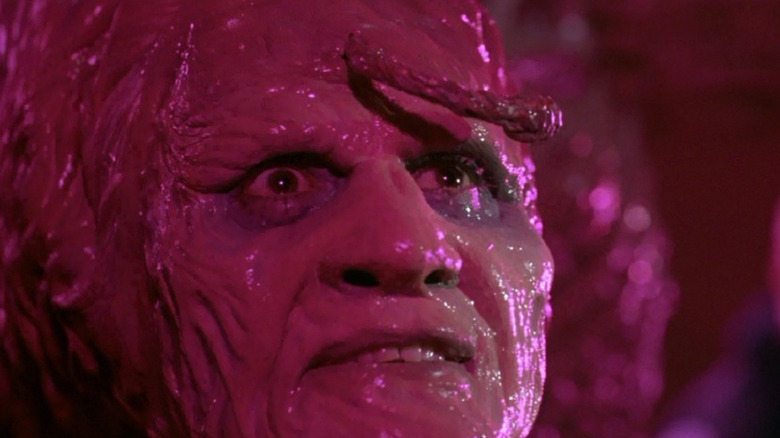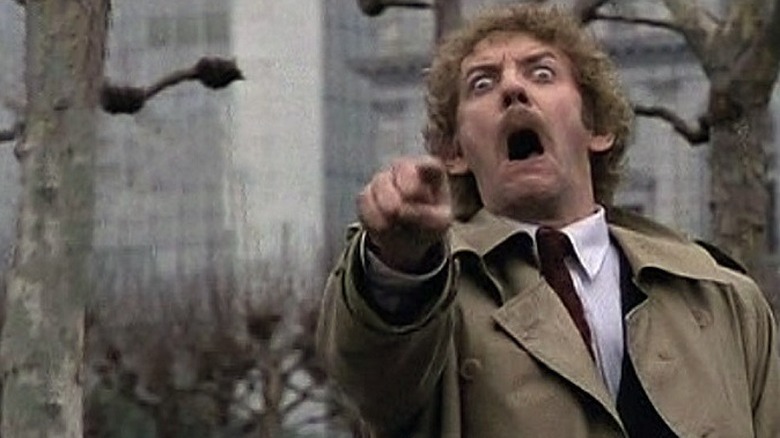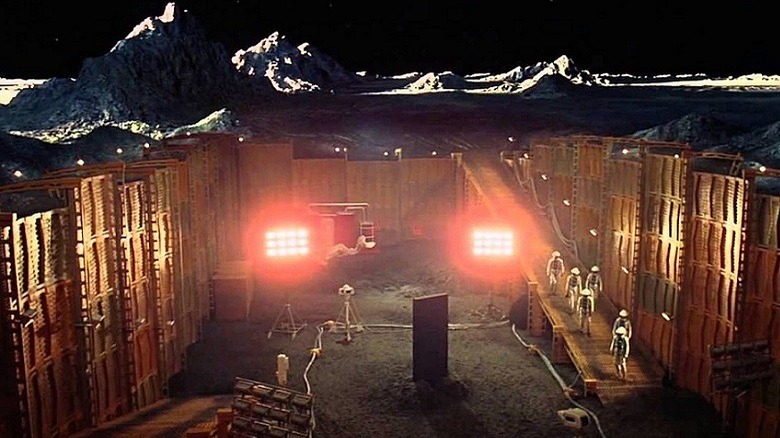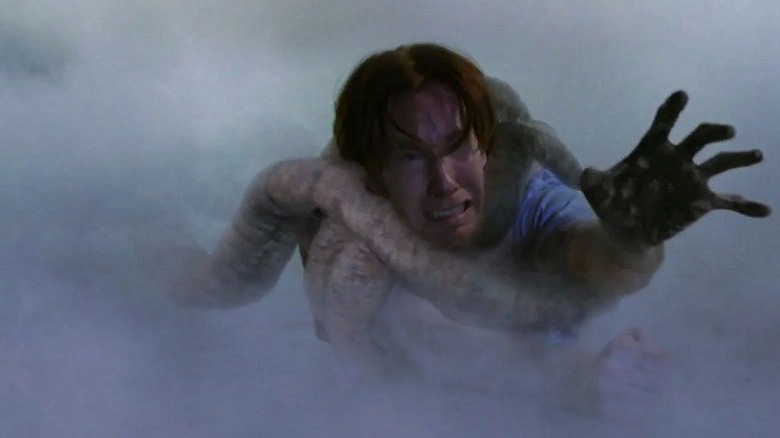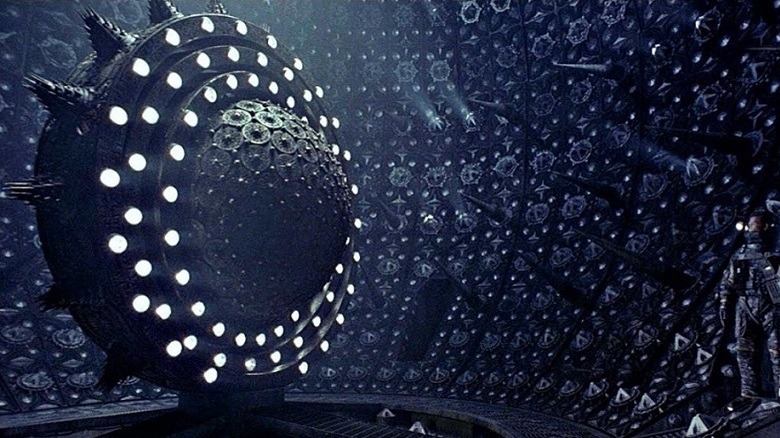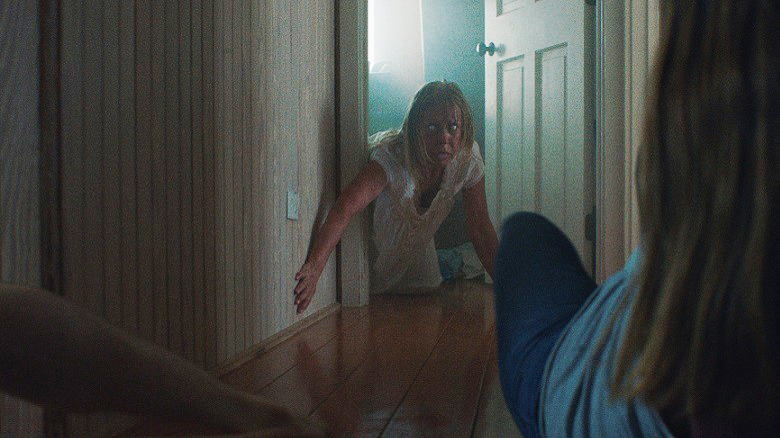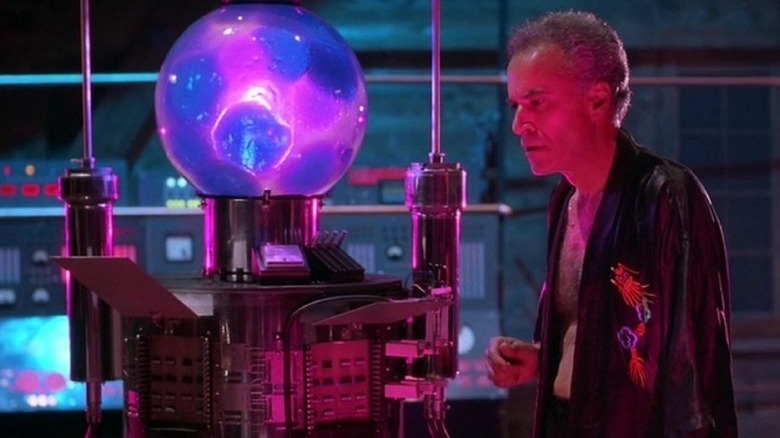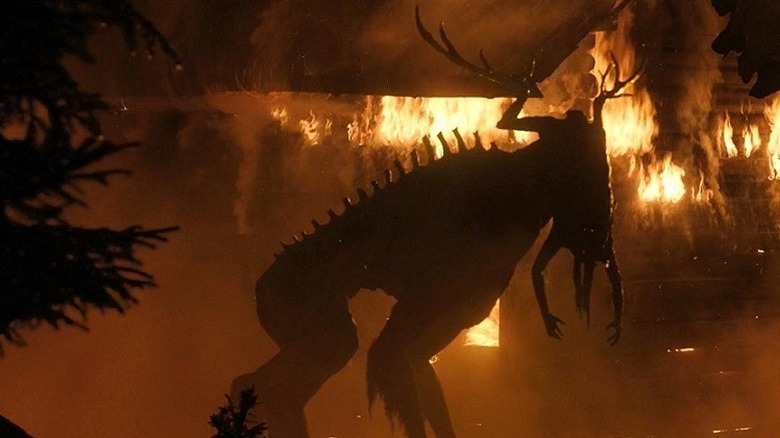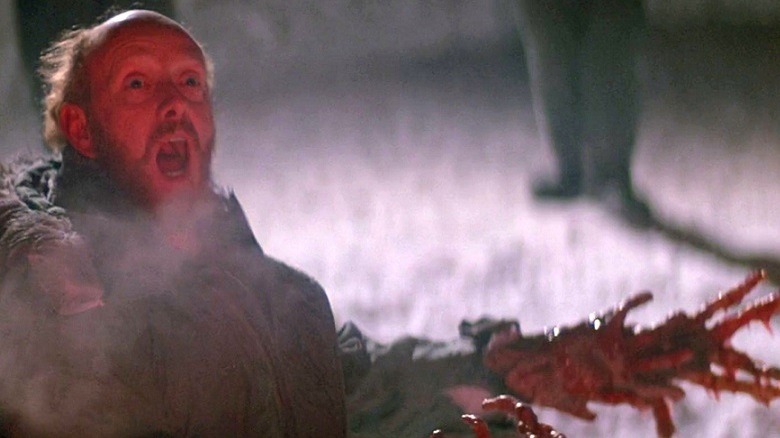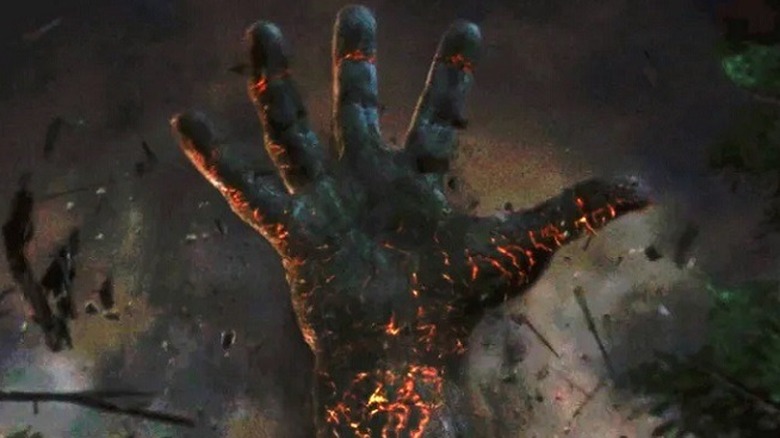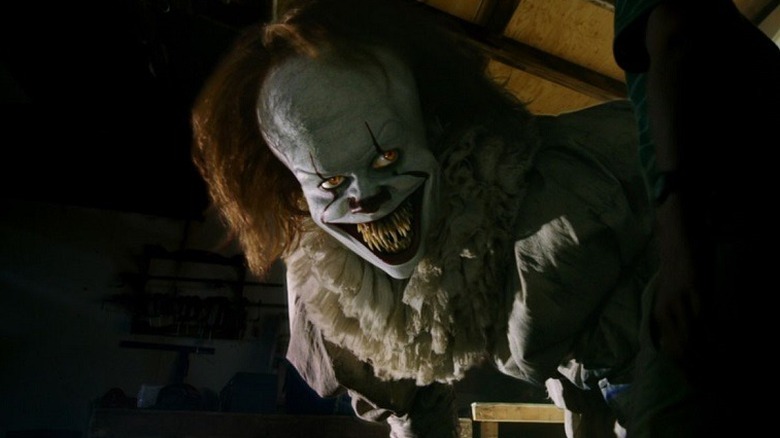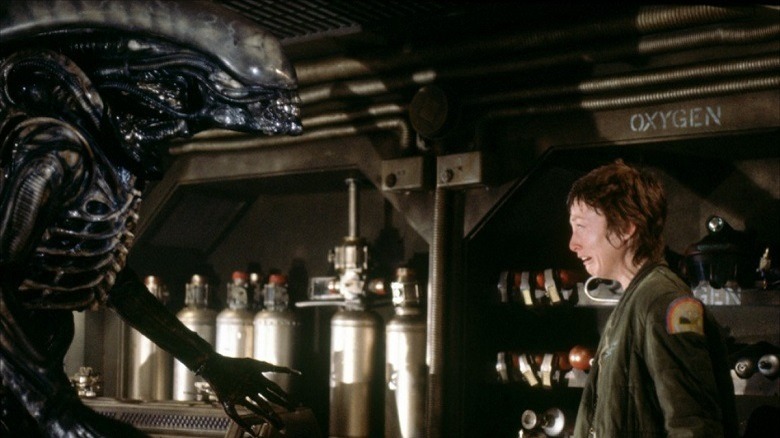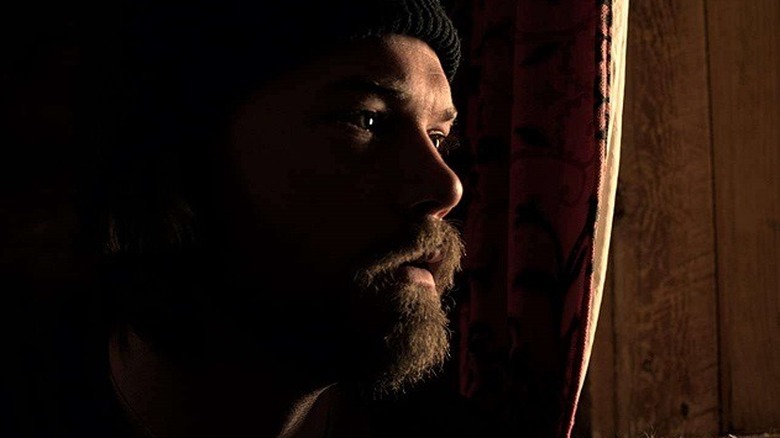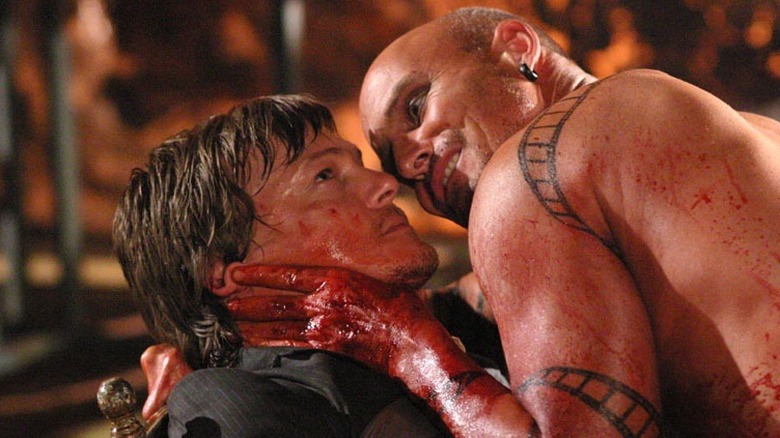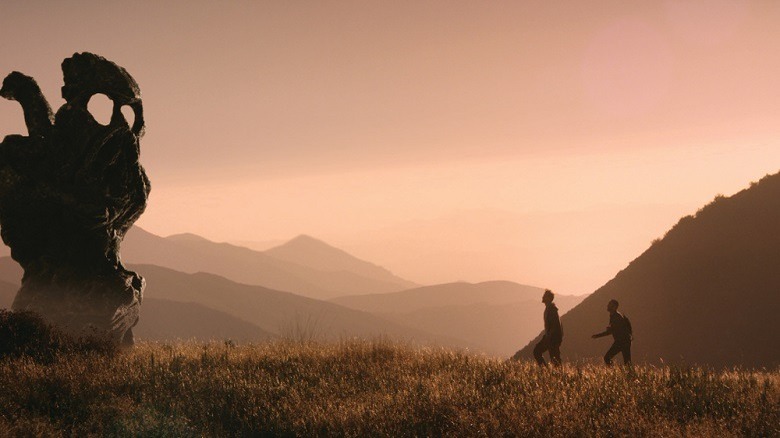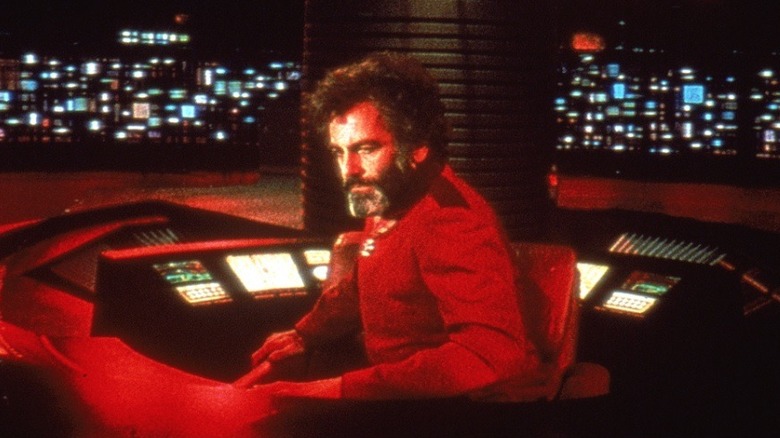The Best Cosmic Horror Movies That Will Make You Hate The Unknown
What is cosmic horror? Typically associated with the works of H.P. Lovecraft and his Cthulhu Mythos (Lovecraft's collection of tales set in a universe of doomed heroes destined for insanity and terrifying God-like beings), it embodies a nihilistic and pessimistic view of reality. In cosmic horror, humanity is mostly insignificant, and people are surrounded by the terrifying unknown. Rather than focus solely on blood and violence, although gore can certainly feature, the terror here comes from the encroaching of the unfamiliar into people's mundane lives.
Existential dread can feature heavily, with humankind realizing how unimportant it is in the grand universal scheme. Humans appear to solely exist to be driven insane, absorbed, copied, or simply devoured in a universe that could not care less about their fate. The following films feature some classic examples of the dangers of the unknown. You might not consider some of them to be horror, but that doesn't preclude them from serving as a reminder of how disturbingly insignificant people are. Continue at your peril, mortal; some things are best left unknown.
Invasion of the Body Snatchers (1956/1978)
If it's not the worry of triffids happily turning the local populace into compost, it's the fear of alien life arriving in the form of seedpods, carried to Earth by the random eddies of solar winds. It comes to something where both the flora and fauna of the great unknown want you gone.
In both the original and superlative remake of "Invasion of the Body Snatchers," an arguable fate worse than death lies in store for the poor victims of the supersized spores. From these giant organic vessels will emerge a ripened replica of you, alike in every way except devoid of all emotion. You will be replaced and, much like an avid cryptocurrency advocate, will want nothing more than to bring other individuals into your freshly cultivated cult. Your opinions and reluctance regarding this process will be duly noted but ignored. It's arguable whether this is a metaphor for Communism or McCarthyism, but regardless, you'll be a lot more content with your new existence, free of the all-too-human weaknesses of joy, ambition, individuality, and grief. The only drawback is that you'll never enjoy peas quite as much ever again.
2001: A Space Odyssey (1968)
You may regard Stanley Kubrick's 1968 seminal science fiction classic (presumably filmed, conspiracy theorists believe, alongside his astonishingly convincing faking of the moon landing) not as cosmic horror, but as a scientifically accurate view of the future of space exploration. But here are the facts: author Arthur C. Clarke's protagonists, The Firstborn, might have been long gone, but their progeny — the impassive black crystalline slabs known as monoliths — are as terrifying as anything found in horror fiction.
With the intelligence of a scale dwarfing humankind, powers over space and dimensional travel, Godlike abilities to shape the advancement of civilization, and the abilities to manipulate reality at well, they're as frightening as anything conjured up by H.P. Lovecraft in his mythos. At least you know where you are with Great Cthulhu. All he wants is to wake from his slumber, feast on the souls of the living, and bring madness and chaos to the universe. Simple pleasures. That the monoliths are so unknowable is the scariest thing of all.
The Mist (2007)
Nebulaphobia is the fear of fog, which is ordinarily a quite benign phenomenon. Usually, the worst that can happen is you might get slightly damp or lost. Unless you're John Carpenter, that is, in which case the fog may harbor malefic murderous mariners. Or, even worse, Stephen King, in which case the thick clouds of water vapor can contain horrific entities from a parallel dimension intent on tearing you limb from limb. From tiny mosquito-like things that will poison your blood, scuttering spiders capable of projecting acidic webs, to giant stomping leviathans resembling something from "Cloverfield," they all want you dead.
As poor old David Drayton (Thomas Jane) discovers in the Frank Darabont 2007 movie adaptation of the 1980 King novella, even hiding out in the local supermarket offers scant comfort. The cruelty and barbarism of the eldritch things lurking outside the windows are equaled by some of the people inside. Even fleeing will undoubtedly result in a horrible ending for all concerned. Weather is unpredictable. Weather conditions bringing an invading force of ravenous beasties? Unpredictable and terrifying.
Event Horizon (1997)
It's not just the things lurking in the inky morass of space that want to eat or impregnate you that you need to be worried about, but space itself. As the hapless explorers of the Event Horizon found on their maiden voyage to Proxima Centauri in 2040, the unknown regions of space might turn out to be some hellish dimension existing outside of the realms of reality.
Faster-than-light travel might sound like a fantastic way to cover extraordinary distances, but the pessimist could also reliably argue based on this movie that it's just a way to get you killed quicker. When the crew of the Lewis and Clark stumble across the titular space hulk floating aimlessly in space, they're doomed from the moment they step on board this modern-day Marie Celeste. The now sentient ship presents them with a maddening myriad of ghosts and blasphemous visions, putting the only survivor off any future space exploration. It would have been best to remain on the Terra Firma of Earth, where there's altogether much less terror.
The Beach House (2019)
If you conveniently forget the whopping Great Old One grabbing 40 million winks under the sea, you'd think a trip to the beach would be relatively harmless. Fresh salty air, the sound of lapping waves and hungry gulls, bioluminescent seaborne clouds of microbes causing hideous mutations... "Jaws" reminded everyone that it wasn't safe to go into the water, and 2019's "The Beach House" pointed out it wasn't that safe lurking on the edges of it either. When a pair of childhood sweethearts show up for what should have been a pleasant break at a family summer beach house, they couldn't have predicted that sun, sea, and surf would mutate into psychosis, sickness, and scares.
Cosmic horror is very aware of the terrors of the oceans. Indeed, the amphibious creatures known as the Deep Ones feature frequently in the works of genre stalwart H.P. Lovecraft and his protégés. "The Beach House" takes full advantage of this, transforming the tranquility of the ocean into a vast unknowable realm concealing all manner of horrors.
From Beyond (1986)
So, terrified by the threats of cosmic horror that lurk everywhere, you decide to stay inside where it's safe. Space travel and trips to the woods or the seaside — all out of bounds. What can go wrong within the confines of your own home? Perhaps a meddling scientist known as Dr. Pretorius invents something called the Resonator, allowing humankind to see beyond the limitations of its primitive five senses. And it so transpires that they're absolutely surrounded by hideous monstrosities at all times, angry carnivorous eels floating through the air that are desperate to devour your head.
Loosely adapted from the 1920 H.P. Lovecraft tale of the same name, Stuart Gordon's "From Beyond" is a stark warning that humankind is never truly safe. Like many of the movies on this list, it's also a reminder that some things are really meant to remain hidden or unseen. As Friedrich Nietzsche said, "...If you gaze into the abyss, the abyss gazes also into you." Had he seen "From Beyond," it's also possible that he might have said, "Don't bother those angry carnivorous eels, or they'll bother you right back."
The Ritual (2017)
What ancient being of unimaginable power isn't complete without their own accompanying cult? And with cults, of course, come cultists, humans who have sacrificed their own humanity and conscience for dedication to a monstrous and singular cause. When five friends go on a hiking tour through Sweden to commemorate their dead pal Rob, they find that there's more to the Nordic country than just pleasant mountain scenery and meatballs, lingonberries, and Brännvin. The intrepid ramblers, forced to deviate from their normal route as a result of an injury of one of their group members, soon inadvertently find themselves at the mercy of a cult.
This sect worship, and summon, a monstrous jötunn that lives in the woods, a towering quadrupedal creature that offers immortality to its loyal followers. The protagonist, Luke, already wracked with guilt over his part in Rob's death, only narrowly survives to see another day. He'll likely never take a shortcut, or dare set foot in a branch of Ikea, ever again. It's an added nightmare when you can't even trust your fellow humans.
The Thing (1982)
Global warming is already a concern for obvious reasons, but the authorities are remaining silent regarding the additional danger — that of crashed flying saucers defrosting and thawing out their iced extra-terrestrial inhabitants. The inhabitants of Outpost 31, an Antarctic U.S. science research station, weren't the ones who dug up and defrosted the titular thing. That was the nosy Norwegians occupying the Thule Station, but the occupants of the American outpost also become targets of the insidious creature.
One of the most alien aliens in cinematic history, audiences never see the true shape of the protagonist, only amalgams of the various forms it has inhabited in its trips across the stars. It's a mimic capable of portraying you with almost unerring accuracy, and the various doomed inhabitants of the research station fall foul to either it or their own increasing paranoia. In the same way that the Body Snatchers (from the movie of the same name) care little for your emotions or idiosyncrasies, the only thing that The Thing wants from you is your biological advantages. Like a cancer, it longs for nothing more than to feed and metastasize its way through a species, hidden among it. Trust no one.
The Cabin In The Woods (2011)
Drew Goddard's sequel-proof, wry comedy horror will change the way you look at horror forever while simultaneously making you wonder what the point of it all is. The nihilism and existential dread that accompanies cosmic horror is blatantly on show here: Humans are just the playthings of the gods, living and dying for their entertainment like actors on some planet-wide reality TV show. It's a plot as clichéd as they come, in which five friends take a trip to a remote cabin, but that's somewhat the point. This meta masterpiece neatly disassembles all of the horror tropes that a savvy audience is all too familiar with. Naturally, the characters meet all the archetypes audiences have seen in countless horrors, like the jock, the smart one, the predictable final girl, and so on.
You can watch every horror film with "The Cabin in the Woods" in the back of your mind, considering them all to be various iterations of entertainment for the Ancient Ones, the God-like antagonists behind the scenes of everything. It's a concept that's as overwhelming as it is smart, but it would be a struggle to be any bleaker an idea.
It (1990/2017)
Even the innocence of youth isn't enough to spare them from a grisly fate at the grease-painted and clawed hands of Pennywise the Clown. The horrifying harlequin — the personification of, effectively, one of H.P. Lovecraft's Elder Gods — first feeds on terror and then directly on the terrified, and reemerges every 27 years to terrorize the citizens of Derry, Maine.
Arriving via a convenient asteroid in the early 18th century, Pennywise's cycle of terror began and continued unabated and would have gotten away with it until his plans were thwarted by meddling kids, Scooby-Doo style. This perennial pierrot can take many forms, presenting itself as its victims' worst fears, which he regards as delicious morsels. Pennywise's natural form (or, at least, the one closest to human comprehension) is a giant spider, so not even arachnophobes are safe. If you find out your hometown is cursed, it's probably best to either not investigate too much, or simply move to another town and never look back.
Alien (1979)
As Douglas Adams proudly proclaimed in the opening to "The Hitchhiker's Guide to the Galaxy," "Space is big. Really big." The vastness of the cosmos, however, can be a double-edged sword. The advantages are that your odds of accidentally encountering a razor-fanged, clawed, and tailed Xenomorph are vastly reduced. The disadvantages are, of course, that in space, no one can hear you scream.
A feature-length training video demonstrating why you really should follow the corporate quarantine advice of your Warrant Officer, 1979's "Alien" sees the crew of the commercial towing vehicle USCSS Nostromo stumble across an alien vessel, its hold replete with dozens of eggs. Quickly discovering that eggs pose a threat beyond mere salmonella, the ill-fated crew find themselves picked off one by one by the inky black predator that hatches from the stomach of their infected executive officer. The alien is the perfect predator: unkillable, lethal, and smart, proving that space is completely lethal and should just be left well enough alone.
Black Mountain Side (2014)
A lot of the horror here teaches people to be scared of things that are ordinarily considered mundane. Trips to the seaside, walking holidays, and strangers are all things to be wary of, but 2014's "Black Mountain Side" adds a whole new element to be terrified of: Architecture. In a remote part of Canada's northern Taiga Cordillera, a group of archaeologists discovers evidence of a settlement anomalous to the territory. Ancient artifacts and structures are uncovered, and with them, something is released. So much of cosmic horror hinges on the discovery of something either hidden through the passage of time or deliberately secreted away to avoid discovery, with the conclusion being that some things are better left hidden or lost.
Things start taking a turn for the worse. Moods are strained, and there's tension in the air. The men begin to suffer physiological and psychological issues, with the film remaining deliberately ambiguous as to the nature of the phenomenon. Is it disease, something supernatural, or a contagious madness? Where there is no vagueness though, is with the men's final fates, rendering it plain and clear that some things should never be tampered with.
Masters of Horror: Cigarette Burns (2005)
Some movies deserve to be lost forever and never found, such as "Santa Claus Conquers the Martians," "Exorcist II: Heretic" and "Highlander II: The Quickening," for instance. However, the plot of "Cigarette Burns," the made-for-TV movie from the 2005 anthology series "Masters of Horror," revolves around finding a lost movie, the existence of which is thought legendary. Norman Reedus, of "The Walking Dead" fame, plays Kirby Sweetman, a cinephile who has fallen into poverty. He's tasked with finding a print of "La Fin Absolue du Monde" which caused a riot on its solo showing and is now believed destroyed.
It's a return to form from horror legend John Carpenter after the execrable "Ghost of Mars," and sits neatly next to the similarly H.P. Lovecraft-inspired Apocalypse Trilogy of "The Thing," "Prince of Darkness," and "In the Mouth of Madness." It's both a love letter to the craft of cinema and a warning regarding its power and also a look at doomed obsession. If the very frames of a frame could cause madness, could you refuse to look? Or like the biblical tale of Lot's wife, would you risk everything for just a glimpse of the forbidden?
The Endless (2017)
You'd think that having escaped an insane desert-dwelling UFO death cult as children, the last thing you'd ever want to do is go back. But that's precisely what Justin and Aaron (Justin Benson and Aaron Moorhead, directors of the first season of "Moon Knight") decide to do. It's when they meet with their old cult that they soon learn that their beliefs might not have been so crazy after all.
"The Endless" is deliberately slow-paced but sets up a palpable atmosphere of discomfort and dread. As otherworldly phenomena begin to manifest themselves, the feeling around the camp is unnerving. It's only over time that the two brothers realize that there might be no getting away this time. Visually imaginative with some excellent and truly chilling set pieces, the film taps into the big fear of the unknown. There's a multi-layered puzzle to be solved here, but you might not be comfortable with the answers.
The Black Hole (1979)
Don't let the familiarity of the comforting Disney brand lull you into a false of security or convince you that 1979's "The Black Hole" isn't a truly hellish indictment of the dangers of space travel. Appropriately named after a phenomenon so powerful that it sucks in all gravity and light, there's a black heart beating within this — on the innocuous surface — romp through space. The "Event Horizon"-lite storyline sees the crew of the USS Palomino encountering the long-lost USS Cygnus, confronting Dr. Hans Reinhardt who plans to live up to the maniacal cackling mad scientist trope by flying into a nearby black hole.
This film may have been made by the House of Mouse, but it's very different from their other kid-friendly output, featuring lobotomized zombified crew members and Maximilian, the creepiest artificial being since HAL 9000's impassive dulcet tones terrified a generation in "2001: A Space Odyssey." Having plunged into the heart of the black hole, the memorable closing shots are of Reinhardt and Maximilian in what can only be described as hell, one hopelessly fused within the form of the other. It's a harsh contrast to the "Happily Ever After" of standard Disney fare.
